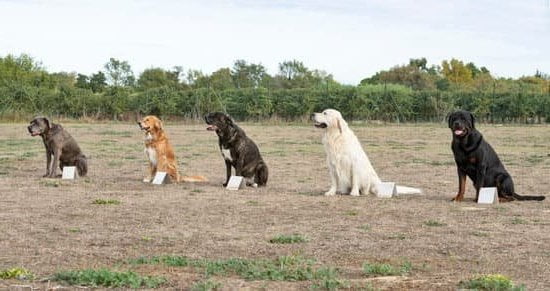Are you looking for ways on how to train a dog not to bark or whine? Excessive barking and whining can be frustrating for both pet owners and their neighbors. In this article, we will discuss various techniques and strategies for effectively training your dog to reduce or eliminate these behaviors.
Understanding the reasons behind barking and whining is crucial in addressing this issue. Dogs may bark or whine due to reasons such as boredom, anxiety, fear, attention-seeking, or territorial behavior. By recognizing the underlying cause of your dog’s vocalizations, you can tailor your training approach to address the specific trigger.
Proper training and consistency are essential in modifying your dog’s behavior. With patience and dedication, positive reinforcement techniques can be used to discourage barking and whining while teaching alternative behaviors. Additionally, managing the environment to minimize triggers and seeking professional help for persistent issues are important steps in the training process.
The Importance of Proper Training and Consistency
Proper training is essential when it comes to teaching a dog not to bark or whine. It is important to understand that barking and whining are natural behaviors for dogs, but excessive or unnecessary barking and whining can be problematic. Consistency is key when training a dog not to engage in these behaviors. This means setting clear rules and boundaries, and enforcing them consistently.
To train a dog not to bark or whine, it is important for the owner to remain calm and patient throughout the process. Dogs respond well to positive reinforcement, so it is crucial to praise and reward the dog when they are quiet and calm. This will help them understand what behavior is desirable and encourage them to repeat it.
In addition to positive reinforcement, it is also important to redirect the dog’s behavior by teaching alternative behaviors. For example, instead of barking at the doorbell, teach the dog to go lay down in their bed when someone arrives. By providing an alternative behavior, you are giving the dog something else to do instead of barking or whining.
| Training Tip | Explanation |
|---|---|
| Remain Calm | Dogs respond well to a calm demeanor during training. |
| Positive Reinforcement | Rewarding good behavior helps reinforce desired actions in dogs. |
| Redirection | Teaching alternative behaviors provides a positive outlet for energy. |
Positive Reinforcement Techniques for Discouraging Barking and Whining
When it comes to training a dog not to bark or whine, positive reinforcement is a key technique that can be highly effective. This involves rewarding your dog for not engaging in the unwanted behavior, rather than punishing them for doing so. Positive reinforcement can include giving treats, praise, or even playtime when your dog is quiet and calm.
One effective method of using positive reinforcement is to employ a command such as “quiet” or “enough” every time your dog starts barking or whining. When they stop making noise, immediately reward them with a treat and plenty of verbal praise. Over time, your dog will learn that being quiet leads to positive outcomes, and they will be more likely to make the connection between their behavior and the rewards.
Another important aspect of positive reinforcement is consistency. It’s crucial to reward quiet behavior every single time it occurs, especially in the beginning stages of training. If you only reward your dog sporadically, they may become confused about what is expected of them and lose motivation to change their behavior.
Training your dog not to bark or whine requires patience and dedication. It’s important to remain calm and consistent throughout the process, as dogs respond best to clear communication and routine. With the use of positive reinforcement techniques, you can effectively teach your canine companion how to control their barking and whining behaviors.
| Positive Reinforcement Techniques | Benefits |
|---|---|
| Rewarding with treats, praise, or playtime | Creates a positive association with being quiet |
| Using consistent commands like “quiet” or “enough” | Helps your dog understand what behavior is expected |
| Remaining patient and dedicated during training | Builds trust between you and your dog while setting clear expectations |
Teaching Alternative Behaviors to Replace Barking and Whining
When it comes to training a dog not to bark or whine, teaching alternative behaviors is an effective approach that can help redirect their attention and minimize these unwanted behaviors. By focusing on replacing barking and whining with other actions, you can encourage more desirable behavior in your furry companion.
Redirecting Their Attention
One effective way to teach alternative behaviors is by redirecting your dog’s attention when they are about to bark or whine. For example, you can train them to perform a specific task or command such as sitting, laying down, or fetching a toy when they feel the urge to bark or whine. By giving them something else to focus on, you can shift their energy towards more constructive activities.
Engaging in Interactive Play
Engaging in interactive play with your dog is another way to replace barking and whining with positive behaviors. Playtime not only provides mental stimulation but also helps release pent-up energy that may be contributing to their urge to bark or whine. Interactive toys such as puzzle feeders or treat-dispensing toys can serve as great distractions and provide an outlet for their natural instincts.
Implementing Obedience Training
Obedience training can also be instrumental in teaching alternative behaviors. By consistently practicing commands and reinforcing good behavior, you can instill discipline and control in your dog’s actions. Commands such as “quiet” or “speak” can be used to regulate their vocalizations, allowing you to have better control over when they should remain silent.
By incorporating these techniques into your training regimen, you can effectively guide your dog towards more desirable behaviors while minimizing their tendency to bark or whine unnecessarily. With patience and consistency, you can help them develop healthier habits that contribute to a more peaceful coexistence within your household.
Using Training Aids Such as Anti-Bark Collars and Devices
When it comes to training a dog not to bark or whine, there are various tools and devices that can aid in the training process. While these should not be relied upon as the sole method of training, they can be effective when used in conjunction with positive reinforcement techniques and consistent training.
Here are some examples of training aids that can help discourage barking and whining:
- Anti-bark collars: These collars are designed to deliver a mild correction (such as a citronella spray, vibration, or sound) when the dog barks. It is important to choose a collar that is humane and safe for your dog, and to use it under the guidance of a professional trainer.
- Ultrasonic devices: These devices emit a high-pitched sound that is unpleasant for dogs, deterring them from barking or whining. They can be used indoors or outdoors to minimize excessive vocalization.
- Automatic deterrents: There are also automated devices available that can detect barking and deliver a deterrent, such as a burst of air or a high-frequency sound. These can be useful for addressing barking when you are not present to intervene.
It’s important to note that while these training aids can be helpful, they should always be used in combination with positive reinforcement techniques and proper training. Additionally, it’s crucial to consult with a professional trainer or behaviorist on how to integrate these aids into your dog’s training regimen. With the right approach and consistency, these tools can play a role in teaching your dog alternative behaviors and minimizing excessive barking and whining.
By understanding how to incorporate these aids into your overall training plan, you can effectively address barking and whining behavior while maintaining your dog’s well-being.
Managing the Environment to Minimize Triggers for Barking and Whining
Dogs can be very sensitive to their environment, and certain triggers can cause them to bark or whine excessively. It is important for dog owners to take steps to manage the environment in order to minimize these triggers and create a calmer, quieter space for their pets.
Identifying Triggers
The first step in managing the environment to minimize barking and whining is identifying the specific triggers that set off your dog. Common triggers include loud noises, unfamiliar people or animals, being left alone, or changes in routine. Once you have identified the triggers, you can take steps to address them and reduce their impact on your dog.
Creating a Safe Space
One effective way to minimize triggers for barking and whining is to create a safe and comfortable space for your dog. This could be a designated area in the home where your dog feels secure, such as a crate or bed with familiar toys and blankets. Providing this safe space can help your dog feel more relaxed and reduce the likelihood of barking or whining.
Establishing Routine
Dogs thrive on routine, so establishing a consistent schedule for feeding, walks, playtime, and rest can help reduce anxiety and minimize barking and whining. By providing structure and predictability in your dog’s day-to-day life, you can create a more stable environment that is less likely to trigger excessive vocalizations.
By taking steps to manage the environment and minimize triggers for barking and whining, dog owners can create a more peaceful living situation for themselves and their pets. With patience and consistency, it is possible to make positive changes to reduce unwanted vocalizations in dogs.
Seeking Professional Help for Persistent Barking and Whining
Sometimes, despite our best efforts, a dog’s barking or whining can persist despite consistent training and positive reinforcement. In such cases, it may be necessary to seek professional help in order to address the underlying issues causing the behavior. A professional dog trainer or behaviorist can provide valuable insight into the reasons behind the barking or whining and develop a tailored training plan to effectively address the issue.
Professional help can be especially beneficial when the barking or whining is rooted in anxiety, fear, or any other behavioral issue that requires specialized knowledge and experience to address. These professionals have the expertise to identify triggers for barking and whining that may not be immediately apparent to a pet owner. Additionally, they can provide guidance on how to modify the dog’s environment and routine in order to minimize these triggers.
When seeking professional help for persistent barking and whining, it is important to choose a reputable and qualified individual with a background in positive reinforcement-based training methods. This ensures that your dog receives effective and humane treatment throughout their training journey. By working closely with a professional, you can better understand how to train a dog not to bark or whine while also fostering a healthier relationship with your pet.
Celebrating Success and Practicing Patience Throughout the Training Process
In conclusion, training a dog not to bark or whine requires patience, consistency, and understanding of the reasons behind these behaviors. It is important to remember that barking and whining are natural forms of communication for dogs, so it’s essential to address the root cause rather than simply trying to suppress the behavior. By utilizing positive reinforcement techniques and teaching alternative behaviors, you can effectively discourage excessive barking and whining in your furry companion.
Celebrating success is an integral part of the training process. When your dog shows improvement in their barking or whining behavior, it’s crucial to acknowledge and reward them for their progress. This can help strengthen the desired behavior and motivate your dog to continue making positive changes.
Additionally, practicing patience throughout the training process is key. It takes time for dogs to unlearn unwanted behaviors and adopt new ones, so it’s important to remain patient and understanding as you work with your pet.
While some cases of excessive barking or whining may require professional help, many can be managed through proper training techniques, consistent reinforcement, and environmental management. Using tools such as anti-bark collars or devices should be approached with caution and only after exploring other positive reinforcement methods. With dedication and a well-structured training plan, you can successfully train your dog not to bark or whine while strengthening your bond with them in the process.
Frequently Asked Questions
How Do I Get My Dog to Stop Barking and Whining?
To get your dog to stop barking and whining, it’s important to identify the cause of the behavior. Once you understand why they are barking or whining, you can address the root issue through training, positive reinforcement, and providing them with mental and physical stimulation.
Can Dogs Be Trained Not to Bark?
Yes, dogs can be trained not to bark excessively. Using positive reinforcement techniques and consistency, you can train your dog to bark only when necessary or to stop barking on command. It’s essential to be patient and consistent with training to see lasting results.
How Do You Discipline a Dog to Stop Barking?
Discipline should focus on redirection and positive reinforcement rather than punishment. When your dog is barking excessively, redirect their attention with a toy or command, then reward them when they comply. Avoid yelling or using aversive methods as these could exacerbate the behavior instead of stopping it.

Welcome to the blog! I am a professional dog trainer and have been working with dogs for many years. In this blog, I will be discussing various topics related to dog training, including tips, tricks, and advice. I hope you find this information helpful and informative. Thanks for reading!





